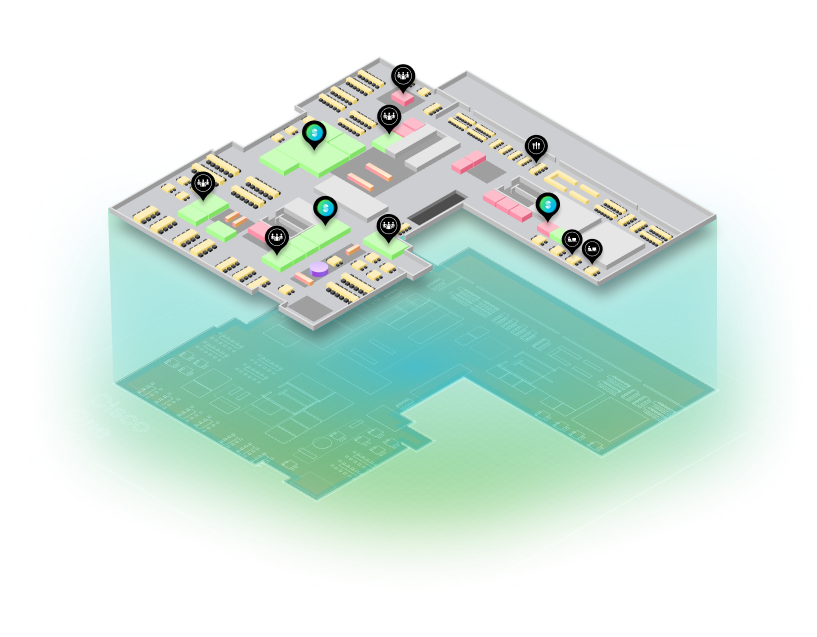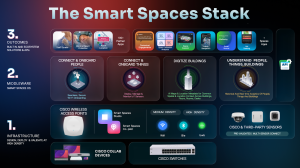
Businesses are constantly seeking innovative solutions to optimize operations, enhance asset visibility, and improve efficiency. Real-Time Location Systems (RTLS) have emerged as a powerful technology that addresses these needs by providing precise tracking of assets, people, and equipment in real time. From healthcare to manufacturing, RTLS is revolutionizing the way industries operate.
In this blog, we’ll break down the fundamentals of RTLS, explore its key benefits and applications across various sectors, and share best practices to help businesses successfully implement this transformative technology. Whether you’re new to RTLS or looking to refine your current system, this guide will provide actionable insights to help you maximize its potential.
What Is RTLS?
Real-Time Location System (RTLS) refers to a technology that enables the automatic identification and tracking of the location of objects, assets, or individuals in real time. RTLS leverages various types of tracking technologies, such as radio frequency identification (RFID), Bluetooth, Wi-Fi, infrared, or ultra-wideband (UWB), to deliver precise location data within confined spaces, such as buildings, warehouses, hospitals, or factories. By providing instant visibility into the exact location of items or people, RTLS can improve efficiency, enhance workflows, and ensure safety across industries. The system typically involves components like tags, sensors, receivers, and software platforms to collect, process, and visualize location data seamlessly.
Unlike GPS, which excels at providing location data in outdoor environments, RTLS is specifically designed for indoor spaces where GPS signals tend to weaken or become unreliable. GPS relies on satellite communication and struggles to penetrate walls or other barriers, making it less suitable for indoor tracking. RTLS, on the other hand, uses localized technologies tailored for indoor scenarios, delivering accurate, continuous tracking even in complex environments such as multi-story buildings. This distinction makes RTLS an essential tool for industries that require indoor asset management or real-time location visibility.
How Does RTLS Differ From Traditional Tracking Technologies?
RTLS differs significantly from traditional tracking technologies like basic RFID or barcode scanning by offering continuous, automated, and highly precise location tracking. While RFID and barcode systems typically require manual scans to capture point-in-time location data, RTLS provides ongoing, real-time updates on the movement and positioning of assets or individuals throughout a space. Once deployed, RTLS operates without the need for human intervention, offering an automated solution that streamlines operations and enhances accuracy. Additionally, depending on the technology used — such as ultra-wideband (UWB), Wi-Fi, or Bluetooth — RTLS can deliver varying levels of precision, ranging from broad room-level visibility to pinpoint centimeter-level accuracy. This unique combination of real-time tracking, automation, and precision sets RTLS apart from traditional systems, making it ideal for dynamic environments that require constant location awareness.
How RTLS Works
Designed for indoor environments where GPS signals are unreliable, RTLS utilizes localized technologies to deliver accurate tracking in areas like warehouses, hospitals, or factories.
RTLS Tags & Receiver Communication
RTLS systems rely on small, wireless location tags attached to assets or worn by personnel, which emit signals at regular intervals. Fixed receivers strategically placed throughout the facility pick up these signals, enabling the system to calculate the precise position of each tag using technologies like radio frequency (RF), infrared, or ultrasound-based communication. The size and functionality of tags often depend on power requirements — batteries power the tags, influencing their lifespan and portability, with smaller tags offering shorter operational lifetimes than larger, more robust units.
RTLS Software & System Integration
The RTLS software processes raw signal data from tags and receivers, transforming it into actionable location information that businesses can use for decision-making. This data is visualized through tools like interactive maps, heatmaps, dashboards, and real-time alerts, allowing users to monitor movement, identify trends, and manage workflows effortlessly. Additionally, RTLS platforms can integrate into existing systems, such as inventory management, security protocols, or workflow automation tools, creating an unified ecosystem for smarter, more efficient operations. This connectivity enhances visibility while supporting data-driven decision-making across industries.
Technologies that Power RTLS
Real-Time Location Systems (RTLS) leverage a variety of technologies tailored to different use cases, environments, and accuracy requirements. From Wi-Fi networks to infrared systems, each technology offers unique strengths and limitations that make them suitable for specific applications.
Wi-Fi
Wi-Fi-based RTLS leverages existing wireless infrastructure, such as access points, to track the location of assets or individuals. By measuring signal strength or triangulating between multiple access points, it achieves location accuracy typically ranging from three to five meters. One of its major advantages is cost savings, as businesses can often utilize their current Wi-Fi infrastructure instead of deploying dedicated receivers, significantly reducing hardware expenses. However, Wi-Fi systems may not provide the ultra-precise location tracking needed for applications requiring centimeter-level accuracy. Wi-Fi RTLS is ideal for applications in retail, warehouses, and general indoor asset tracking, where moderate accuracy is sufficient and scalability is key.
Bluetooth Low Energy
Bluetooth Low Energy (BLE) is rapidly gaining popularity for RTLS implementations due to its energy efficiency, cost-effectiveness, and growing ecosystem of beacons and tags. BLE works by using small wireless devices that transmit signals to receivers, allowing for location monitoring with an accuracy typically in the range of one to three meters. BLE tags boast low power consumption, enabling extended battery life and reducing long-term operational costs. Additionally, BLE’s ease of deployment, including minimal infrastructure requirements and scalability, makes it ideal for applications like asset tracking, employee monitoring, and proximity detection. Its versatility has made BLE a common choice for industries like manufacturing and healthcare.
RFID & Active RFID
RFID-based RTLS systems use radio frequency to identify and track assets, with a key distinction between passive and active RFID technologies. Passive RFID tags rely on external energy sources, like RFID readers, to activate and transmit data, making them cost-effective but limiting their read range to a few meters. On the other hand, active RFID tags have their own power sources, offering long read ranges — sometimes up to 100 meters — but at a higher cost. Passive RFID is typically used in inventory or supply chain management for point-in-time tracking, while active RFID is preferred for applications requiring ongoing tracking, such as vehicle or large equipment monitoring in logistics and construction.
Infrared & Ultrasound
Technologies like infrared and ultrasound are highly specialized RTLS solutions designed for environments that demand room-level or sub-meter accuracy. Infrared systems operate using line-of-sight signals, which are extremely precise but can suffer from physical obstructions and interference from environmental light. Ultrasound systems, on the other hand, transmit high-frequency sound waves to track location and offer similar levels of precision while being less prone to light-related interference. Both are ideal for healthcare applications, such as patient monitoring or medical equipment tracking, due to their ability to deliver pinpoint accuracy even in confined spaces. However, the specialized infrastructure and environmental requirements can increase deployment complexity and costs.
Top Benefits of RTLS For Organizations
Real-Time Asset Visibility
RTLS provides continuous insights into the location and movement of assets, helping businesses significantly reduce search time and improve asset utilization. For example, in large hospitals, RTLS can locate medical equipment such as wheelchairs or IV pumps within seconds, saving staff hours of manual searching daily. This visibility ensures assets are not sitting idle and are used optimally while also maintaining accurate inventory counts without frequent audits, minimizing discrepancies and reducing shrinkage. In logistics, RTLS prevents misplaced packages or delays, giving organizations the tools to track changes in inventory immediately and boosting overall effectiveness in asset management.
Improved Operational Efficiency
By automating workflows and providing actionable insights, RTLS streamlines processes, identifies bottlenecks, and optimizes labor allocation. For instance, in manufacturing facilities, RTLS systems track equipment and workers to detect production delays or inefficient movement patterns, allowing for immediate adjustments to improve throughput. Distribution centers can use RTLS to direct workers to high-priority areas based on real-time demand, ensuring labor is allocated effectively. Furthermore, automating data collection reduces the time spent on manual tracking tasks and mitigates human error, allowing staff to focus on more productive efforts while improving overall operational accuracy across the business.
Safety & Compliance
RTLS significantly enhances workplace safety while streamlining compliance with regulatory requirements. In emergencies such as fires or hazardous material leaks, RTLS systems can pinpoint the location of personnel in seconds, facilitating faster evacuation and response times. Sensitive environments like factories or research labs can use RTLS to prevent liability risks by flagging unauthorized access attempts and restricting entry to specific areas. In healthcare or high-risk industries, RTLS automates documentation needed for regulatory audits, tracking employee activity or medical device usage, ensuring compliance seamlessly without manual oversight while improving organizational accountability and preparedness.
Cost Savings
RTLS systems can reduce operational expenses through better resource allocation, theft prevention, and process optimization. Real-time visibility prevents unnecessary asset purchases, as organizations can pinpoint underutilized equipment and redistribute resources more effectively, significantly cutting capital expenses. By tracking asset usage, RTLS enables businesses to schedule maintenance only when required, reducing costs associated with over-servicing while extending equipment lifespan. In addition, RTLS mitigates theft and loss by closely monitoring high-value assets, preventing financial losses and supporting more efficient budget allocation.
What Are Some Common RTLS Use Cases?
Healthcare
In healthcare, RTLS is extensively used to enhance operational efficiency and patient care. Hospitals and healthcare facilities deploy RTLS to track medical equipment, monitor patients, and streamline staff workflows. For example, RTLS helps locate critical medical devices like infusion pumps or ventilators instantly, ensuring they are available when needed, thus saving valuable time and improving patient outcomes. Additionally, RTLS facilitates patient flow management by monitoring patient locations and movements, reducing wait times and improving care coordination across departments. Staff safety is also a significant benefit, as RTLS systems often include duress buttons and automated alerts to quickly assist personnel in emergencies. Furthermore, RTLS aids in infection control by enabling contact tracing and exposure management, crucial for managing contagious diseases and ensuring a safer environment for patients and staff.
Manufacturing
Manufacturing facilities utilize RTLS to optimize production processes, track materials, and enhance worker safety. For example, RTLS enables work-in-progress tracking by monitoring the movement of components through assembly lines, identifying any delays and streamlining production workflows. Tool management is another critical application; RTLS ensures that essential tools and equipment are always within reach, minimizing downtime and improving productivity. In hazardous environments, RTLS plays a key role in safety compliance by tracking worker locations and ensuring they are kept away from dangerous areas, which helps in adhering to safety protocols. Moreover, RTLS helps identify bottlenecks and inefficiencies in production processes, enabling managers to implement corrective actions and improve overall operational efficiency.
Warehousing & Public Venues
In logistics operations and large public spaces, RTLS is instrumental in inventory management, security, and enhancing the visitor experience. Warehouses leverage RTLS for real-time stock location and quantity verification, ensuring inventory accuracy and reducing the likelihood of stockouts or overstock situations. This real-time information significantly optimizes pick paths during order fulfillment, leading to faster and more accurate shipments. In large public venues such as stadiums or convention centers, RTLS helps monitor visitor flow, preventing overcrowding and improving the overall visitor experience. It’s also crucial for emergency response, as RTLS enables coordinated evacuation and enhances safety procedures by providing real-time insights into the location and movement of individuals within the venue.
What Are The Essential Steps for Deploying RTLS?
1. Define Clear Objectives
Before starting the RTLS implementation, organizations must establish specific goals and metrics that guide the deployment. This involves identifying particular operational challenges rather than adopting the technology for its own sake. For instance, a hospital may focus on reducing the time spent searching for equipment like IV pumps or improving patient flow, while a warehouse may prioritize optimizing pick paths for faster order fulfillment. Clearly defining problems ensures that RTLS deployment solves tangible issues rather than being an abstract upgrade.
Success metrics should also be developed to measure the effectiveness of the RTLS system. Key Performance Indicators (KPIs) such as time saved locating assets, improved asset utilization rates, or enhanced workflow efficiency serve as benchmarks for success. Additionally, stakeholder alignment is essential to ensure all relevant departments — from IT and operations to frontline staff — understand the objectives and benefits of the system. For example, in manufacturing facilities, clear communication about RTLS’s role in tracking tools and improving worker safety fosters collaboration and smooth adoption across teams.
2. Plan Infrastructure
The physical and technical infrastructure of the RTLS system plays a critical role in achieving optimal performance. Effective planning should begin with a site assessment to evaluate physical spaces and environmental conditions. For example, facilities with dense machinery or high signal interference need tailored solutions to avoid disruptions. A healthcare facility might need to assess potential radio frequency interference caused by medical devices, while public venues may need to evaluate structural features such as floor layouts or multi-level spaces.
Coverage planning should follow, ensuring proper receiver placement for complete area coverage. For instance, warehouses and factories benefit from strategic placement of RFID, BLE, or Wi-Fi receivers to cover aisles and open spaces efficiently without leaving blind spots. Similarly, healthcare facilities may require room-level accuracy with receivers placed strategically in specific zones like patient wards and surgical suites.
Organizations must consider network integration, as RTLS systems typically require robust wireless connections and sufficient bandwidth. Ensuring the facility’s network infrastructure can support the added data stream is vital — this may involve upgrading existing networks or implementing dedicated RTLS networks, especially in larger facilities. Additionally, attention should be paid to scalability for future expansion. Whether the goal is expanding to additional floors, covering new facilities, or integrating new technologies, upfront planning ensures the RTLS solution can grow alongside operational needs.
How to Choose the Right RTLS Solution
Selecting the right Real-Time Location System (RTLS) is crucial for ensuring that the technology effectively meets your organization’s needs while providing long-term value. A well-chosen RTLS solution aligns with operational goals, supports future growth, and integrates seamlessly with existing systems. These are a few key considerations…
- Accuracy Requirements: Identify precision needs (e.g., room-level for hospitals, aisle-level for warehouses) to match use cases without overinvesting.
- Scalability Needs: Ensure the solution supports current needs and future expansion without major upgrades.
- Total Cost of Ownership (TCO): Evaluate upfront, maintenance, and hidden costs; balance affordability and long-term sustainability.
- Integration Capabilities: Prioritize systems that integrate seamlessly with existing tools (ERP, WMS, patient care software) for centralized workflows.
- Vendor Evaluation: Choose vendors with industry expertise, proven deployments, strong customer support, and commitment to innovation.
How RTLS Delivers Real-Time Insights & Future-Ready Operations
Unlocks Real-Time Operational Insights
RTLS-generated data offers organizations far more than just location tracking — it delivers actionable insights that drive operational efficiency. By aggregating real-time data from people, equipment, or workflows, RTLS powers operational dashboards that enable live decision-making. For instance, in a hospital, staff can rapidly locate and move medical equipment to critical areas during peak demand, while manufacturing supervisors can reroute workers from idle zones to address production bottlenecks. These dynamic adjustments improve responsiveness and help maintain smooth operations across industries.
Historical RTLS data adds deeper value by identifying recurring patterns, such as high equipment idle times, inefficient labor allocation, or crowd congestion in specific zones. These insights inform process redesign, resource optimization, and improved workflows. Additionally, predictive analytics derived from RTLS data can anticipate future requirements, such as forecasting asset demand, optimizing maintenance schedules, or planning labor distribution. This level of operational intelligence ensures organizations are better prepared to manage growing complexities and disruptions.
Powers Smarter Buildings Through Location Intelligence
RTLS is a critical enabler of smart building trends, transforming physical spaces into adaptive, responsive environments. By integrating real-time location data, facilities can automate operations, improve sustainability, and enhance occupant experiences. For example, RTLS can adjust HVAC settings based on room occupancy, optimizing energy use and improving comfort while reducing waste. Insecure or unauthorized zones can trigger alerts based on live location data, enhancing security and compliance across the building.
RTLS also drives resource optimization by eliminating redundancy. Facilities can avoid unnecessary equipment purchases through improved asset utilization, streamline space management, and cut operational costs by minimizing underused spaces. Platforms like Cisco Spaces harness RTLS technology to layer location intelligence onto existing infrastructure, creating buildings that respond intelligently to dynamic needs while maintaining sustainability and efficiency.
Supports Strategic, Scalable Growth
RTLS solutions are designed to support scalability for multi-location enterprises, enabling centralized visibility and cloud-based monitoring. Organizations can deploy RTLS across a single site as a pilot project and later expand its capabilities across other locations without reworking their infrastructure. For example, companies can maintain remote oversight of assets or workflows spanning multiple facilities, gaining enterprise-wide insights from a unified, scalable platform.
Deployments that integrate RTLS into existing ecosystems are particularly valuable, as they reduce complexity and avoid expensive rip-and-replace scenarios. Cisco Spaces, for instance, allows organizations to scale RTLS-based initiatives by leveraging their existing Cisco infrastructure, enabling seamless implementation and enterprise-wide transformation. With robust scalability, flexible cloud integrations, and real-time monitoring, RTLS ensures businesses remain future-ready amid constant growth and change.
Unlock the Power of RTLS With Cisco Spaces
Real-Time Location Systems (RTLS) deliver transformative benefits, such as improved visibility into assets, staff, and workflows, optimized operations that reduce bottlenecks, enhanced safety through real-time monitoring, and data-driven decision-making powered by actionable insights. By leveraging location intelligence, organizations can streamline processes, minimize downtime, and proactively address challenges to create more efficient and safer environments.
Choosing the right RTLS solution is critical — it should be scalable, flexible, and compatible with existing infrastructure to support long-term growth without overcomplicating deployment. Cisco Spaces stands out by turning Cisco networks, like Wi-Fi 7 access points, into IoT gateways, eliminating the need for additional hardware such as legacy gateways. With features like asset tracking, occupancy monitoring, and environmental telemetry, Cisco Spaces enables organizations to simplify IoT deployment while aligning with future-ready strategies.
To explore the full capabilities of Cisco Spaces, take the Product Tour and learn how to redefine your physical spaces into intelligent, connected ecosystems.


